Blog
Archives
.
. . from 2015 to current
SATURDAY
FEBRUARY 29 - 2020
Crane
over Emsworth!
David Minns
tells me his neighbour saw a Common Crane flying over
North St Emsworth this morning (Sat) at about 11.00!
It was flying from East to West, fighting against the
wind and being escorted by a gang of gulls. David is
pretty sure this is a genuine record, as his neighbour
has seen Cranes before and has no incentive to make up
things like this!
I had a quick look at the HOS and SOS recent
sightings, but the last Cranes reported in Hampshire
and Sussex were in April and May 2019.
The Hampshire Bird Report describes the Crane as a
rare vagrant. However, it goes on to say . . .
"With
the recent creation of breeding programmes in
Gloucestershire and Somerset there is now a small
population of free-flying released birds that range
widely in Southern England. These birds carry colour
rings that are not always obvious in flight. It is
therefore assumed that all (reported) birds are of
captive origin unless there is strong evidence to the
contrary".
It is my guess that Derek's neighbour probably saw one
of these released birds, though I would be happier
with that conclusion if the bird had been seen and
reported by other birdwatchers.
The only Common Crane I have in my records is one
photographed by Derek Mills at Titchfield Haven on
Thursday 2 March 2017. From other observers at the
time Derek gathered this bird was a female Crane
ringed in Somerset in 2013. Here is Derek's cracking
shot of the bird.

Nore
Barn
Neal Scott was
at Nore Barn on Wednesday (Feb 26) for almost an hour
and took a few snaps of the Spotted Redshank which was
looking good, It will be leaving us fairly soon for
its long journey back to the breeding grounds in
Northern Scandinavia. As this is its 16th year it
should know the way pretty well by now.
See the Spotted Redshank page for full details . . .
Spotted
Redshank at Nore Barn

Neal also got some
shots of the Spotshank's regular feeding companion,
the colour-ringed Greenshank G+GL including one of it
'crabbing'. There was no sign of the similarly
colour-ringed Greenshank G+LG spotted recently by
Peter Milinets-Raby.

Neal noticed that in
addition to the G and GL rings the Greenshank also had
a metal ring with an engraved number (possibly 317) at
the bottom of the right leg. This is a British Museum
ring with a specific number which I believe all
British ringed birds have to have. As clearly shown in
Neal's photo below, the Greenshank also has a red ring
on the bottom of its left leg. This 'marker' ring
indicates the bird was ringed by the Farlington
Ringing Group - in this case on 22.9.2014.

WEDNESDAY
FEBRUARY 26 - 2020
Emsworth
Harbour
This morning
Peter Milinets-Raby decided to visit the Emsworth area
for just over an hour from 9:12 am. His report follows
. . .
It was bright and
sunny, but very cold with a strong chilly north wind
blowing. The tide was slowly pushing in. The harbour
looked rather empty and the totals seen reflected
this!
Beacon Square: 6 Ringed Plover with a single Dunlin, 4
Shelduck, 5 Brent Geese and a single Little Grebe.
Emsworth Harbour: 6 Shelduck, 10 Med Gulls, 8 Teal,
104 Brent Geese, 133 Dunlin, 2 Grey Plover, 1 Great
Crested Grebe, 3 Red breasted Mergansers.
1 Greenshank in the pond outflow by the yacht club
with colour rings. I thought it was the Nore Barn
bird, so I made note of the time (9:54am) and randomly
took a couple of photos as the bird was relatively
close. It was a bit shy and not sure of my
presence.
At Nore Barn (10:05am) the first bird I saw was the
colour ringed Greenshank and thought that was a nifty
quick fly round!!! Then, I noticed the Lime ring was
below the Green ring and realised it was a different
bird!!! I was so pleased that I had taken the record
photo of the earlier bird (See photo on left).
The regular Nore Barn Greenshank with the green ring
above the lime (G+GL) is on the right below - taken
by Peter on Feb 12. So there are two very similar
ringed Greenshank in the area.
Also at Nore Barn in
the stream right next to the walkway bridge was the
Spotted Redshank - it alas got chased off by a
dog.
Other birds of note were 53 Dunlin, 3 Shelduck, 1
Turnstone, 42 Brent Geese, 28 Teal and a flock of 120+
Golden Plover flew off Thorney Island and headed
towards north Hayling.
TUESDAY
FEBRUARY 25 - 2020
Spotted
Redshank
I nipped over
to Nore Barn at about 12 noon mainly to check on the
Spotted Redshank. The tide was already well advanced
and the stream full. However, the ever reliable
Spotted Redshank was roosting on the edge of the
saltmarshes with a Brent Geese nearby keping company.

On the basis of past
years he should be here for another 4 weeks before
leaving for the breeding grounds in Northern
Scandinavia. See the Spotted Redshank page for full
details . . . Spotted
Redshank at Nore Barn
Warblington
birds
Freshly
returned from a family holiday at the Solway Firth in
Scotland, Peter Milinets-Raby had a wander around his
home patch in the Warblington area and shore this
morning for 90 minutes. Tide pushing in and rain fast
approaching!! His report follows . . .
In the fields around
Castle Farm were 5 Cattle Egrets and 6 Little Egrets
(The Cattle Egrets are showing orange washes on their
foreheads and crowns, plus a smudge down the mantle.
Not easy to photograph in the strong sunshine).

1 male Pheasant. Also
feeding in the field to the west of the cemetery were
62 Mediterranean Gulls with 20+ Black-headed Gulls. A
spectacular sight. I had forgotten (after not seeing
any for four plus months) how stunning they are!!!
Also 1 Meadow Pipit.

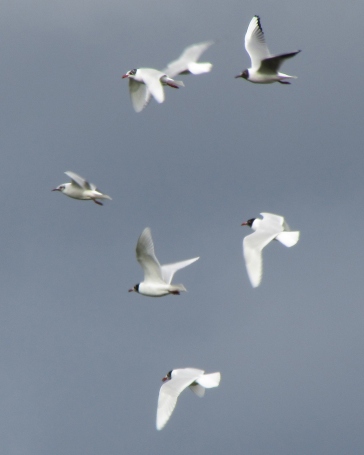
The Big field out
east. 31 Brent Geese, 1 Jay Heard,
Straw dump: 5 singing Skylarks, 1 Rock Pipit, 4 Water
Pipits, 2 Pied Wagtails, 25+ Linnets, 1 Buzzard over.
A small clump of
Wild Pansies caught my eye.

Conigar Point: 8 Red
Breasted Mergansers, 224 Brent Geese, 29 Shelduck, 67
Dunlin, 24 Wigeon, 1 Great Crested Grebe, 13 Grey
Plover.
SSSI Field held a very smart summer plumaged male
Stonechat and 1 Meadow Pipit
Pook Lane: A pair of Pintail on the sea (see photo).

56 Brent Geese
including the coloured ring bird Blue "C" + "F". 16
Wigeon, 3 Red Breasted Merganser, 1 Kestrel.
SUNDAY
FEBRUARY 23 - 2020
Chaffinch
demise!
The British
Trust for Ornithology has published its latest
assessment of the size of bird populations in the UK.
Wren continues to hold the title of our commonest
breeding bird with 11,000,000 pairs, followed by Robin
(7,350,000 pairs), House Sparrow (5,300,000), and
Woodpigeon (5,150,000). Chaffinch and Blackbird share
the number five spot at 5,050,000 territories each.
Turtle Dove numbers have dived from 75,000 pairs in
1997 to just 3,600 pairs.
But most alarming is the decline in the Chaffinch
breeding population which has fallen by 1.15 million
pairs since the last report seven years ago. They say
the reasons for this decline are unclear and need
further investigation. See . . . https://bto-enews.org/IG4-6QCS6-3RN36S-3Y4KPA-0/c.aspx
This shocking news of
the Chaffinch decline comes as no surprise to garden
birdwatchers like myself. Chaffinch sightings in my
Emsworth garden have fallen dramatically since about
2008 as the following chart shows. The largest
Chaffinch collapse was last year when I saw a
Chaffinch on only two weeks in the year - in early
March 2019. I shall keep my eyes skinned for any
repeat performance this year.
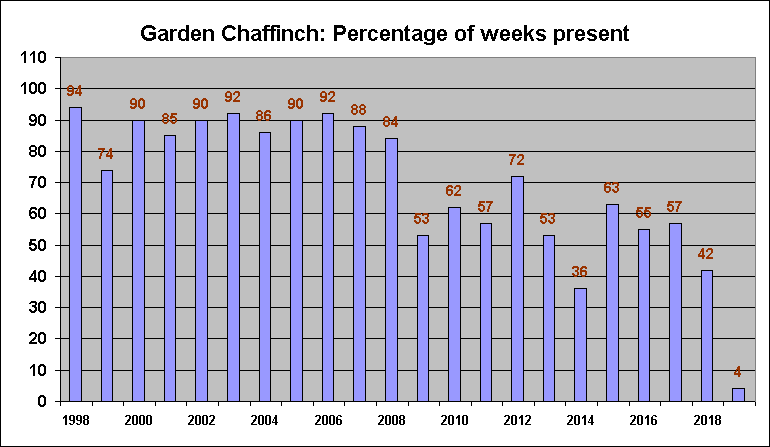
Greenfinch has
undergone an even more dramatic decline as shown in
the following chart. Greenfinch was until 2007 the
number one bird in my garden with a 100% turn out
throughout the year. However, in 2008 the disease
trichomonosis decimated the Greenfinch population with
a dramatic effect on garden sightings to the point
last year when I went the whole year without seeing a
single one in the garden. Unbelievable!
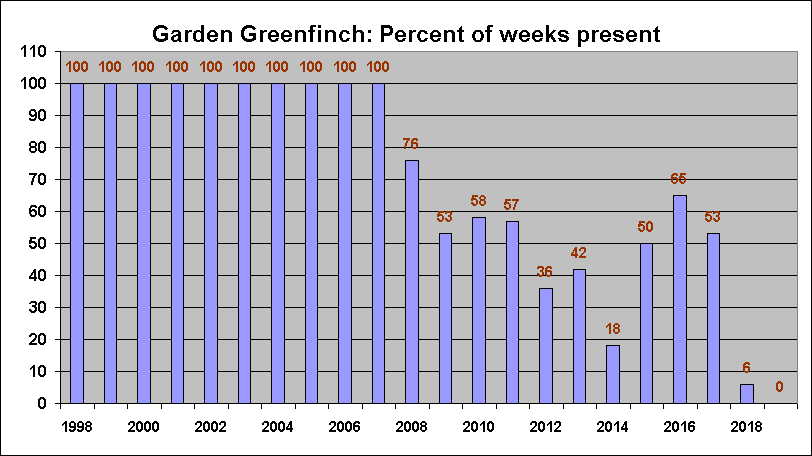
First
Blackbird song
Poking my head
out of the back door at 6pm this evening I was regaled
by the dulcet tones of my first Blackbird song of the
year from a neighbour's garden. Last year I first
heard the first Blackbird in Bridge Road on Feb 16;
today's bird one may well have been singing earlier
and I did not hear it. I suspect others will be
singing around the area at this moment. In this area
Blackbird starts singing between Feb 15-24 each year.
Early evening is the best time to catch this wonderful
songster establishing its territory. Here is a photo
of an early Blackbird I took last year.

Orchid
verge damaged
The
construction work taking place on the grass verge near
the Warblington roundabout where the Bee Orchids grow
has finished and the verge has been reinstated with
fresh soil of some sort. I suspect the orchids will be
lost after this disturbance, but you never know.
Wildlife has a tendency to bounce back when all seems
lost, so we must keep an eye on it. Here's a photo
taken last year of the verge with orchid area marked.
It is not easily accessible across the main
road!

Solent
Aware
Emily Jupe who
has been monitoring the Emsworth area for Solent Aware
is moving on and taking on a new position with the
RSPB. We appreciate the work that Emily has done to
enhance interest in the harbour birds in the local
area and shall certainly miss her enthusiastic
presence. Emily reassures us that the good work of
Solent Aware will continue.
Main contact . . .
Elizabeth.Hibberd@hants.gov.uk
SATURDAY
FEBRUARY 22 - 2020
Brook
Meadow
During a
stroll through Brook Meadow this afternoon I was very
pleased to get a good view of a female/juvenile
Kestrel hunting. Kestrel is a fairly common bird
around the meadow, but this was my first sighting of
the year. The following photo and video clip shows the
bird perched in a tall Crack Willow tree, peering
down, looking for sign of prey. I saw it drop down a
couple of times, though seemingly not catching
anything.

Video clip of the
Kestrel . . . https://youtu.be/9VwjGkLlM5g
I searched around the
main Butterbur site below the central seat and managed
to find a few spikes starting to flower. I shall be
doing my annual count of this striking plant in about
a month.

Walking along the
causeway towards the Lumley gate I stopped to admire
the glorious while blossom on the Cherry Plum tree
which does not seem to have suffered from being
severely cut back by conservation volunteers during
the winter. The white blossom contrasts nicely with
the yellow of the Gorse.

Millponds
news
A pair of Mute
Swans is now well settled on Peter Pond and maybe will
stay to nest build. I think this is a new pair as the
pen of the old pair was killed by a dog and the cob
driven off. There was no sign of the second pair that
has been on Slipper Millpond, and I suspect they may
have been driven off by the Peter Pond pair, or just
gone of their own accord!
Correction:
Pam Phillips tells me the old pen swan died of old age
and was not killed by a dog (Brendan witnessed this ).
There is a second pair of swans that swim around
Slipper Mill pond at the same time as the other pair
are on Peter pond.
I also had a look at
the town millpond where I found a male Red-breasted
Merganser with its tuft being blown around by the
strong wind. A female has also been seen on the pond,
but it was not there today.

Stansted
Forest
This morning's
walk by the Friends of Wildlife group was at Stansted.
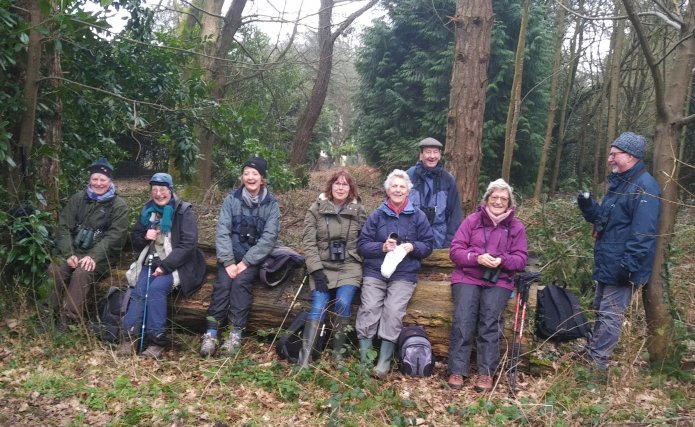
Helen Penfold's report
with photos can be seen at . . . http://familyfellows.com/hwg-walk-reports-2020.htm
THURSDAY
FEBRUARY 20 - 2020
Brook
Meadow work session
This morning's
work session on Brook Meadow was reasonably well
attended considering the weather forecast for more
wind and rain. However, the rain held off and the 10
volunteers managed a couple of hours of good
productive work under the leadership of Colin
Brotherston (5th from the left).

The main tasks were:
1. to lay gravel along the path from the Seagull Lane
gate to the north bridge
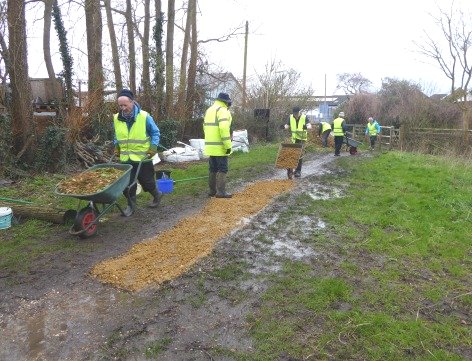
2. to spread wood
chippings left by Michael Reed along the muddy paths
immediately below the north bridge

3. to dig out some of
the brambles on the edge of the orchid area

The path completed

For a full report on
the work session and more photos go to . . .
https://www.brookmeadow.org.uk/conservation-news/
Other
observations
The River Ems
is still in flood. This photo taken by Colin shows the
river in Palmer's Road Copse and the sluice gate with
the water high on both sides.

A Cherry Plum tree in
the Seagull Lane hedgerow has been pushed over by the
strong winds exposing its roots. The conservation
group will attend to it in a future session.

The Summer Snowflake
(Leucojum aestivum) near 'my' Oak tree on the Seagull
Lane patch has opened more flowers.

Lesley Harris showed
us a 9 carat gold bracelet that she had found in a
bush close to the interpretation board on the Seagull
Lane patch. Lesley put a notice on the board about the
bracelet, but has had no responses. If anyone has lost
one or knows who it might belong to please get in
touch with Lesley at . . .
lharrisemsworth@ntlworld.com
Fungi
Nicola Hammond
sent me this excellent photo of fungi growing in tiers
on a dead log in the south meadow. We see these quite
often on the meadow, growing in tiers on dead
branches, etc. They are called Many-zoned Polypore
(Coriolus versicolor).

SATURDAY
FEBRUARY 15 - 2020
Hayling
Billy Line
Tony reports
on this morning's walk by the Friends of Wildlife
group
Eight brave souls took on Dennis this morning. We
walked Northwards on the Billy Line from the station
theatre for a good hour, coffee, turned round and
walked back to the car park for about 11.30, just
defeating the rain and wind by 15 mins.
Easy.
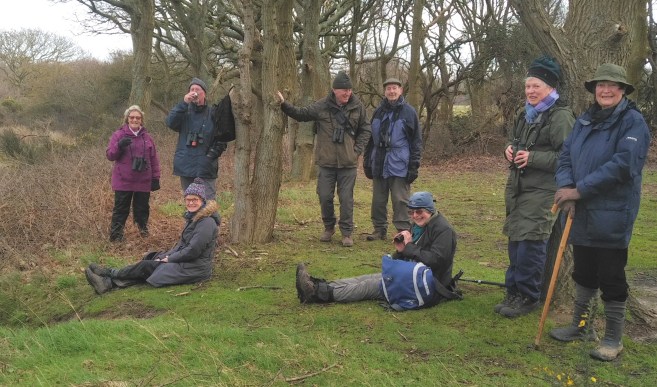
The first discussion
was an alder in the car park hedgerow. Which is the
male part and which is the female. There were lots of
last years fruit plus plenty of catkins (the male) but
where were the female parts. Definitely not the little
red buds that we found because they were from the
adjoining hazel. We did in the end find the alder
female buds.
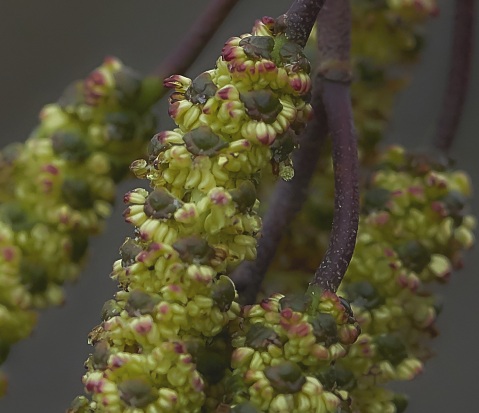
Brian's
note on Alder catkins
The photo seems to show underdeveloped male
catkins. They are turning just now and will soon all
become yellow with pollen. Female Alder catkins are
dark red, short and erect and subsequently turn into
cones. Here is a photo I took on Brook Meadow a couple
of years ago showing both male and female catkins
together. Some of last year's dark cones can be seen
on the left of the photo.
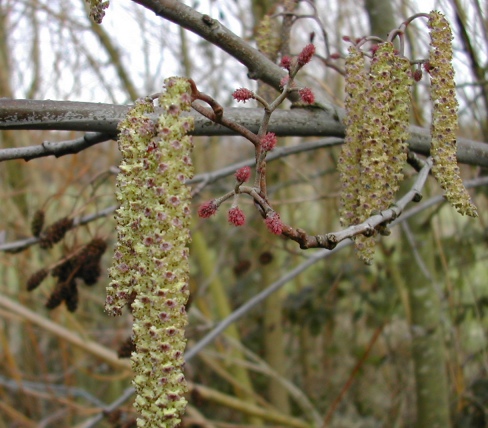
Flowering plants we saw were sea radish, sow thistle (
probably last years still going), snow flakes, winter
heliotrope, cherry plum ,sweet violets and butchers
broom. Photos show Gorse and Sweet Violet.
Birds we saw included,
Canada goose, Brent, RB merganser, little egret,
kestrel, oystercatcher, curlew, black headed gull,
herring gull, wood pigeon, dunnock, robin, blackbird,
blackcap, longtail, blue and great tits, magpie,
carrion crow, house sparrow, chaffinch, greenfinch,
goldfinch, plus the star of the morning a MED
GULL.
Thanks to everyone making the effort to come out and
defy Dennis. Well done.
FRIDAY
FEBRUARY 14 - 2020
Brook
Meadow
Early this
afternoon, the weather was so mild and spring-like
that I had a little nose around the meadow and what a
joy it was. The birds were singing and the first signs
of spring were emerging in the flora.
I was greeted at the
Seagull Lane gate by the usual cacophony of House
Sparrows chattering in the huge Russian Vine (Fallopia
baldsschuanica) which wild and rampant on the hedge at
the bottom of Seagull Lane opposite the entrance gate
to Brook Meadow. This plant is a wonderful habitat for
birds and today, in addition to House Sparrows, I
heard the songs of Robin, Wren and my first Dunnock of
the year. Later on in the walk I also picked up Great
Tit and Song Thrush. Spring is in the air!
From the Seagull Lane
gate, I made my way along the mown path beside the
laid hedgerow on the west side of the patch where I
admired the attractive growths of Ivy on the mottled
bark of the Field Maple and on the gnarled trunk of a
Hawthorn. When mature Ivy provides a valuable wildlife
habitat and, contrary to popular opinion, it does no
harm to the tree it grows on. I like to see them more
as companions than foes!

A bit further on, I
was stopped short by a crop of dazzlingly green Holly
leaves in the hedge. Nearby I found male catkins and
female red flowers on a Hazel.

Nestling among the
nettles beneath the hedgerow were several bright
yellow flowers of Lesser Celandine. The number of
petals on Celandines varies from 6 to 13. This one had
a modest 9 petals, though I spotted one along the
north path with 12 petals!

At the far end of the
hedgerow is a mass of fallen apples on the ground. Dan
used some of these last autumn to make apple jelly and
gave me a pot to sample!
I looked at river bank clearance done recently by
Maurice and Terry which has served to open up a view
of the river as well as creating a suitable habitat
for Water Voles.

The Oak tree that I
planted in 2012 is growing well and as in previous
winters has retained its leaves, unlike the Mayor's
Oak nearby which has shed all. Leaf retention is not a
problem and both trees are healthy.
Almost beneath 'my' Oak is the long standing (and
badly misnamed) Summer Snowflake (Leucojum aestivum)
which has just started to open its attractive white
bell-shaped flowers with green tipped petals.

I walked along the
north path, recently cleared by volunteers during work
sessions, looking good in the sunshine.
The lone self-seeded Alder on the river bank at the
north bend now has flowering catkins with yellow
pollen.
It was good to see a small clump of Snowdrops at the
start of the path from the north-east corner. I
plucked one to have a closer look at the inner flower
with its green lined petals. I think this one is
called a 'double'.

I walked through the
Gwynne Johnson Rowan plantation on the east side of
north meadow where the ground is thickly carpeted with
a lime coloured moss. It pays to have a close look at
this delicate plant which has feather-like leaves
which I tentatively identify as Rough-stalked
Feather-moss ( Brachythecium rutabulum).
This moss has also partially covered the Environment
Agency's flood defence bags at the back of the Rowans.

The Agency have
cleared a wide track down to the Lumley Stream giving
a good view of the currently fast flowing stream
looking south. It will be interesting to check this
track in the spring for anything of interest.

I have been checking
the Butterbur area below the main seat over the past
couple of weeks for any sign of early growth without
luck, but today I discovered a number of first buds
pushing through the ground and starting to open. Soon
the area will be full of the pink-flowered spikes -
ready for the annual count in mid-March.

Warblington
Peter
Milinets-Raby visited the Warblington fields and the
shore this morning for a couple of hours from 9am.
Tide out. His report follows . . .
The best bird was observed whilst I was watching 2
Water Pipits and a female Reed Bunting foraging in the
Straw Dump. I was taking photos of one of the Water
Pipits, when it stretched its neck up and called in
alarm (See photo).

Slightly to the right
was a male Kestrel hovering perfectly still. I turned
my camera on it and reeled off 200+ photos over the
next six minutes (according to the clock in the
camera). The Kestrel hovered for a minute, then
dropped to the ground.

It came up with a Vole
in its talons, then conveniently flew to a fence post.
where it ripped the poor Voles head off, before
pulling out all the guts and swallowing the last bit
whole. Gone in six minutes! A shame about the dull
grey conditions, but the photos catch some of the
colourful nature of the kill!
Elsewhere this
morning: In the fields around the farm were 12 Little
Egrets, 5 Cattle Egrets (including Tufty), 4 Redwing,
127 Brent Geese and 5 Med Gulls (calling and pairing
up - already!!!).
The Cemetery held a Green Woodpecker, a Great Spotted
Woodpecker and a singing Coal Tit. The Big Field out
East held 23 Brent Geese, 10 Skylarks, 8 Linnets and 2
Jays
Conigar Point - low tide. 4 Great Crested Grebes, 11
Grey Plover, 33 Dunlin, 6 Shelduck, 11 Brent Geese, 3
Common Gull, 5 Red Breasted Merganser and 4
Wigeon.
Off Pook Lane were 81 Shelduck, 8 Wigeon, 202 Brent
Geese, 88 Dunlin,, 9 Grey Plover 11 Lapwing and 2
Golden Plover. Has gone very quiet as if winter is now
over!
THURSDAY
FEBRUARY 13 - 2020
Brook
Meadow work
Maurice Lillie
and Terry Lay did some sterling work today in clearing
the west bank of the River Ems north of the north
bridge. Maurice says there is still a lot of clearing
up to do, taking care to reduce the likelihood of
people, other than those necessarily there for
maintenance purposes, having access. The main reason
for this work is to continue the quest to create good
habitats for Water Voles. The photo is taken from the
opposite bank.

Winter
Swallow
This morning
at Salterns Quay Portsmouth Eric Eddles was amazed to
see a single Swallow heading north!! Early arrival or
wintering bird? In either case I feel for that poor
bird!
Mystery
fungi
Keith Wileman
found some interesting fungi on a fence panel he'd
just had delivered. The largest are about 7mm
diameter. Strangely they were all turned to reveal
their gills, which are normally hidden on the
undersides. I have never seen downside up fungi
before. Would this strange behaviour have something to
do with the storage of the fence panels?

WEDNESDAY
FEBRUARY 12 - 2020
Emsworth
Harbour
Peter
Milinets-Raby spent three hours out along the Emsworth
esplanade from 9am to Mid-day - tide coming in. Here
is Peter's comprehensive report and superb photos . .
.
Here's a scenic
view of the western harbour looking west towards
Langstone

Beacon Square:
26 Dunlin, 3 Ringed Plover, 2 Red Breasted Mergansers,
6 Shelduck, 1 Little Grebe.
Emsworth Harbour: 1 Little Grebe, 7 Red
Breasted Mergansers, 4 Teal, 3 Common Gull, 224
Dunlin, 8 Grey Plover, 124 Brent Geese, 4 Shelduck, 2
Little Egrets, 4 Wigeon, 14 Lapwing, 1 Great Crested
Grebe, 2 Canada Geese, 8 Turnstone.
1 Adult Med Gull in virtual summer plumage and calling
to herald in spring!
Emsworth Pond: A very obliging female/juvenile
Red Breasted Merganser
Nore Barn (from
10:15am): Solent Aware in situ doing a great job! 250+
Dunlin, 84 Wigeon, 3 Grey Plover, 10 PINTAIL
(Yippee!!) six males and 4 females, 58 Teal, 2
Shelduck, 36 Brent Geese, 1 Rock Pipit feeding in the
dinghy's.
Eventually the Spotted Redshank and the coloured
ringed Greenshank flew into the stream - I could not
resist taking a few photos!! The Spotted Redshank to
my eye had an extra amount of barring along the right
flank by the vent.
MONDAY
FEBRUARY 9 - 2020
Langstone
Mill Pond
Peter
Milinets-Raby was out this morning for an hour to
check after the storm Ciara. He visited Langstone Mill
Pond for about an hour from 9am. Tide coming in. Not
much to report . . .
The pond held a pair of Tufted Duck and 2 Teal. The
Grey Heron on Nest 14 was amazingly still there. Adult
males were standing on Nests 4 and 9.
Off shore were 40 Teal, 16 Wigeon, 67 Shelduck, a
female Goldeneye, 6 Lapwings and 178 Brent Geese.
In the flooded paddock were 6 Grey Herons, 7 Little
Egrets, 45 Teal, 3 Wigeon and 3 Pheasant.
SATURDAY
FEBRUARY 8 - 2020
Havant
Thicket
Heather Mills
reported on this morning's walk by the Friends of
Wildlife group
13 met at Havant Thicket to walk into the grounds of
Staunton to try our luck at hearing and seeing a
Lesser Spotted woodpecker.
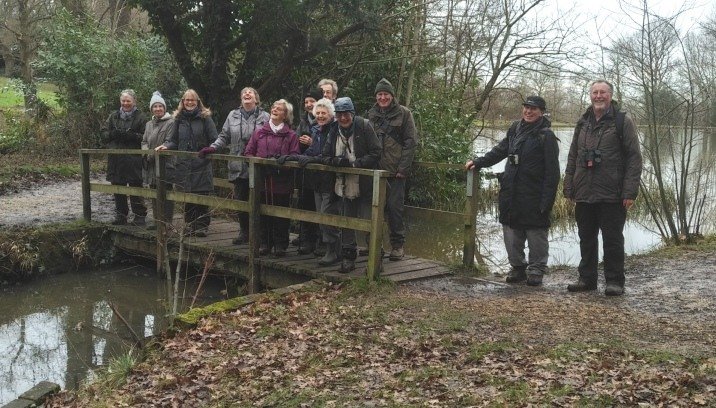
To begin our walk we
were rewarded with 4 Song Thrushes probing the soil
near the car park and a few more seen throughout the
grounds.
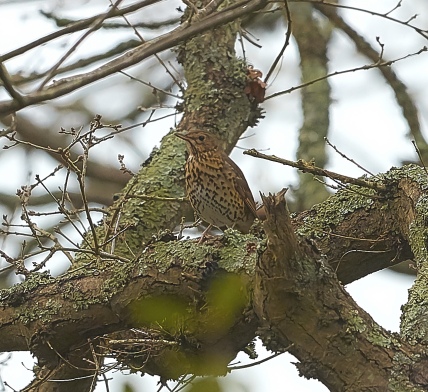
Pairs of Blue and
Great Tits called from the vegetation lining the
pathway as we began. Very soon a close encounter with
a Buzzard also excavating the soil, flew and hid
behind a branch of a very sad looking Oak in the
middle of the field.
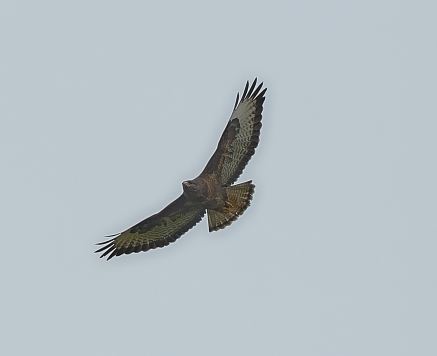
The weight of the
limbs to one side, looked like it had taken its toll
by splitting the main trunk of the tree. Coal tits
were very vocal and gave us a chance to focus on the
song. We did hear several short bursts of Great
Spotted Woodpecker and had a good chance to see 1 of 2
pairs nearby. The first one showed red on his head as
he avidly pecked at the dead wood. (picture is a
female).
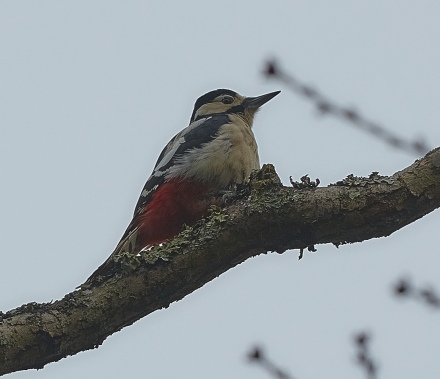
As we had changed our
direction due to all the keen runners, we decided to
stop and have our break early. A pair of Nuthatch were
excavating a large hole in a nearby Oak.
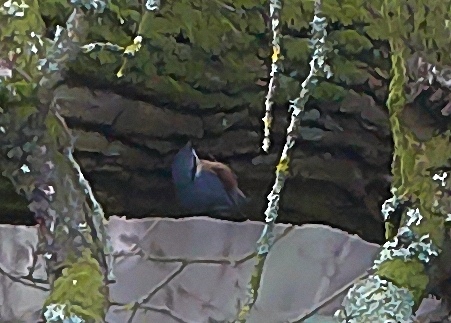
A Goldcrest was
singing in the Yew. Neill pondered over a name for a
"small trumpet" flowering bush next to a wonderful
scented Mahonia. We continued around the lake and
everyone listened out for the possible drumming with
no luck. However, on our return a Kite flew overhead,
spotted by Val and Dave. Further on they also had
really good views of a pair of Great Spotted
Woodpeckers in the Silver Birch, right above us. As we
passed Gypsy plain once more we noted 17 Magpies
across the field where the sheep grazed.
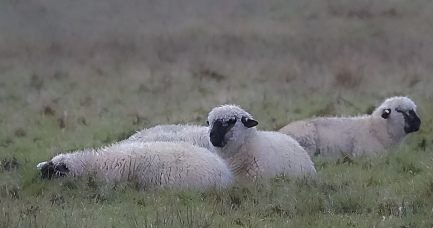
A pair of Stonechat
flitted across the grass tops, and later another pair
were seen with Skylarks. As we neared the car park,
the hedgerow gave views of 3 Chaffinch 2 males and a
female and a number of Goldfinch. Linda spotted
movement and some saw the Green woodpecker alight in
the nearby Birch. 30 species seen.
Gorse and Herb Robert were out in flower. Primroses
were not quite out. Osiers looked a spectacle.
THURSDAY
FEBRUARY 6 - 2020
Spotted
Redshank
I went over to
Nore Barn at 10am one hour after high water mainly to
check on the Spotted Redshank which had not been
reported by anyone for the past two weeks which is
unusual. Brian Lawrence did not see it during a visit
to Nore Barn yesterday, though he says the tide was
right out when he was there. I was not too concerned
as the bird does tend to go AWOL for short periods
and, personally, I have not been quite as vigilant in
checking as I usually am.
However, there was no mistaking its very familiar form
this morning, busily feeding among the weed on the
edge of the fast flowing stream and completely
ignoring people and dogs walking on the path within
yards of where it was feeding.

The Spotted Redshank
is, of course, well used to me standing still with
camera pointing in its direction! When a dog wandered
into the stream the bird would nonchalantly walk away
with its beak in the air! Dogs! It is truly an amazing
little bird.
Here is a short video
clip of the Spotted Redshank feeding in the stream . .
. https://youtu.be/cyk49HdlLSc
We are approaching the
time when the Spotted Redshank will be leaving us,
usually mid to late March. Last year my last sighting
was on Mar 23rd. See the special Spotted Redshank page
for all the first and last sighting dates since
2004.
Go to . . . Spotted
Redshank at Nore Barn
WEDNESDAY
FEBRUARY 5 - 2020
Emsworth
Harbour
Brian Lawrence
had a walk along Western Parade from Nore Barn to
Emsworth and got a good selection of bird photos.
The regular
colour-ringed Greenshank (G+GL) at Nore Barn

Black-headed Gull with
a worm

Pair of Red-breasted
Mergansers

House Sparrow and
Dunnock in the woods
MONDAY
FEBRUARY 3 - 2020
Swan
Goose on the way!
Nick Rule
e-mailed to say there is another China Goose (aka Swan
Goose) on its way to Emsworth from Westbourne
Millpond; he says, this one is going to be much harder
to catch. Last time we had one of these exotic birds
gracing Peter Pond for a few days in early January
before it was 'rescued'.

If you see the bird
please call Nick on 07880 893970 or e-mail at . . .
rulen12@googlemail.com.
Warblington
shore
Peter
Milinets-Raby had a walk around Warblington and the
shore this morning from 9am to 10:30am - low tide. The
details were as follows:
In the fields around Castle Farm (not necessarily in
the same field) were 20 Little Egrets and 5 Cattle
Egrets (One of these is developing a unkempt shaggy
crest just like the individual from last year - making
it possibly the same bird?)
Ibis field. Chiffchaff in the hedge by the stream
feeding happily.
Big field out east; 61 Brent Geese including 17
juveniles amongst them - these birds seriously
contemplating their immigration status post Brexit
(See photos). Will they have border checks when they
return next winter?

Straw Dump; 1 Grey
wagtail, 2 Water Pipits, 3 Pied Wagtail, 14 Skylark -
two singing, 11 Curlew, 5 Stock Doves.
Spring is blooming early with flowers noted in the
stubble field were a nice extensive clump of Red
Dead-nettle flowers (one attached via mobile phone)
and several patches of tiny violas.

Conigar Point: Lesser
and Great Black-backed Gull, 139 Brent Geese, 26
Shelduck, 9 Grey Plover, 12 Wigeon, 147 Dunlin, 1
un-ringed Greenshank, 1 Red Breasted Merganser, 18
Canada Geese heading east along the channel.
SSSI field; 2 Meadow Pipits.
Pook Lane: 30 Wigeon (close in feeding on sea grass -
see photo).

114 Brent Geese
including ringed bird - Blue "C" and Blue "F" -
same bird seen late last year (See photo). Originally
ringed in Middle Beacon Island, Pyasina Delta, Taimyr
on 29th July 2008. Since that date, the bird has been
reported twelve times, mostly from Peterswarf,
Langeneb, Nordfriesland (2011 and 2012) and from
Northney, Hayling Island in February 2014 and Havant
December 2014.

58 Shelduck, 10 Grey
Plover, 45 Dunlin, 10 Teal, 2 Greenshank (RG//- +
YY'//-).
SUNDAY
FEBRUARY 2 - 2020
Brook
Meadow Workday
There was a
good turn out of 13 volunteers for this morning's work
session on a bright and breezy day.

The bonfire had
already got started when I arrived at 9.30 and was
going all morning.

Video - bonfire . . .
https://youtu.be/iiDjcrwZZIQ
The main task was to
collect and burn up the various piles of cuttings from
previous work sessions.

This was a big job
which the volunteers set to with their usual
enthusiastic gusto.

For a full workday
report and more photos go to . . . https://www.brookmeadow.org.uk/conservation-news/
Wildlife
observations
There was a
good selection of bird song around the meadow this
morning including Robin, Wren, Great Tit and 4 Song
Thrushes, two on the north meadow and two on the south
meadow. That augers well for the breeding season.

The white blossom is
now emerging on the Cherry Plum on the causeway and
should be a fine sight in a couple of weeks.

This tree was well
trimmed by the conservation group in an earlier
session and makes an attractive contrast with the
yellow of the Gorse right opposite.

There is also a
smaller Cherry Plum in full flower on the river bank
at the north bend. Blackthorn is not yet out, always
later blossoming than the Cherry Plum.
I spotted a single Lesser Celandine flower on the
river bank along the north path, though there will be
many more in the coming weeks.

Other
news.
Mike reported seeing two Spotted Redshanks in the Nore
Barn stream. This is not unusual, though it is the
first sighting of two this winter.
Neill reported seeing a flock of Greenfinches on the
allotments behind Bath Road. This is particularly
interesting in view of the scarcity of this once
common species in gardens due to the disease
trichomonosis.
Hermitage
Millponds
From Brook
Meadow I walked down to Peter Pond where I found the
new pair of Mute Swans on the grass bank near the
seat.

There was a second
pair on Slipper Millpond by Chequers Quay. It will
certainly be interesting to see if both pairs manage
to nest.

Early
Spring?
Mark Wagstaff
spent this afternoon watching a pair of Robins
building a nest in his Lee on Solent garden.
Interestingly, they chose to nest in a predator proof
(or at least cat proof) Schwegler nest box which has a
large hole and a very deep box, rather than one of the
regular Robin open front ones. Mark will keep us
posted on the outcome. I would be interested to hear
of any other early nesting efforts.
As for spring flora,
Mark adds that he's had Daffodils in flower for over
two weeks and virtually all of his Camellia bushes
have flowers on. I have seen Lesser Celandines on
wayside verges and the first Sweet Violets on the
grass verge on Warblington Road near the junction with
Valetta Park. Cherry Plum blossom is now out, but not
Blackthorn which always follows later.
As for insects, Mark
put a bee box out a week ago just in case an early
queen is out looking! Here in Emsworth we have had a
large white-tailed Bumblebee (Queen?) buzzing around
the garden over the past two days.
A couple of weeks ago we had a Red Admiral inside the
house. Following advice from Butterfly Conservation we
placed it in a cardboard box and located it in a shed
outside. Sadly, it did not survive a cold spell. Red
Admirals rarely survive our winters, even a mild one
like this.
SATURDAY
FEBRUARY 1 - 2020
Bosham
Heather Mills reports on this morning's walk by the
Friends of Wildlife group . . .
12 met in Bosham to a serenade of Song Thrush, whilst
male Blackbirds jostled in the surrounding trees. The
sun shone briefly as we ventured to the shoreline.
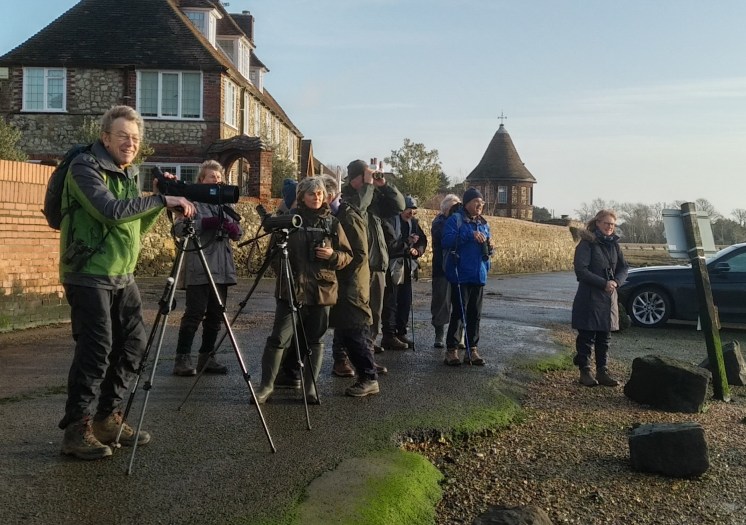
At least 8 Turnstone
scrabbled in the bladder-wrack and Brent roosted
unusually quiet, on the edge of the mud at low tide. A
Curlew gave us good views as we scanned for species
nearby. Whilst the noisy Oystercatchers let us know
they were about. A couple of Turnstone and one Grey
Plover seen in the distance. Black-headed gulls in the
channel were joined above on the large posts by a
gathering of a dozen juvenile Herring Gulls.
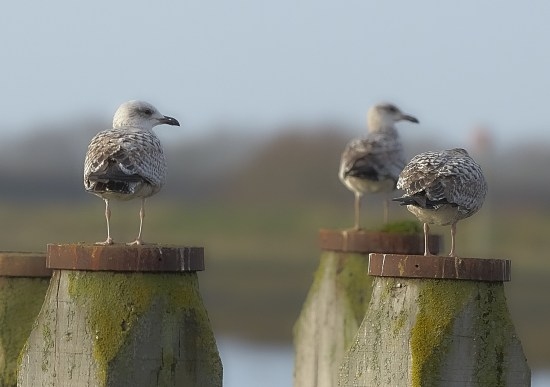
A lone Greenshank gave
a wonderful opportunity for close views as it fed in
the tidal flow as we ventured to the edge of the
pontoon.
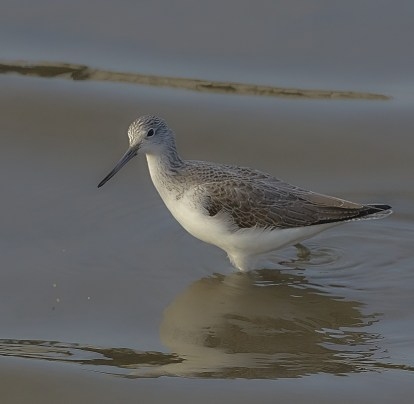
3 Little Grebes dived
constantly out in the main channel looking south with
another 6 diving as we looked northwards, together
with a Cormorant. A flock of Common Gulls were on the
opposite shore. A large group of Shelduck settled on
the mud, with a couple of pairs dotted around having
paired up probably.. A few Mute swans with signets
still in tow swam amongst numerous Wigeon along the
tidal edge. Teal and further on some spectacular
Pintail seen bathing. The agility of some of our group
had to be seen to be believed as we slid over the wall
to access part of our walk which encountered a
descending onto a slippery coastline.
On the field opposite Colner creek we settled to have
a welcome break from the westerly wind. Here, as soon
as we approached, a welcome sight of Mistle Thrush was
spotted by Caroline and gave us views through her
scope. Soon after the delightful sight of 3 Skylarks
chasing each other were noticed alighting the field. 2
began to sing and eventually 4 were seen.
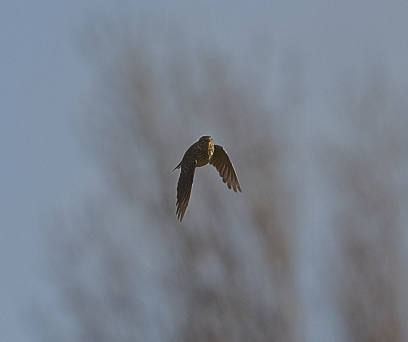
As the fields were
waterlogged, we decided on a return route through the
back roads. This was delightful for the lovely views
of our first Lesser Celandine together with plenty of
Snowdrops and Winter Heliotrope.
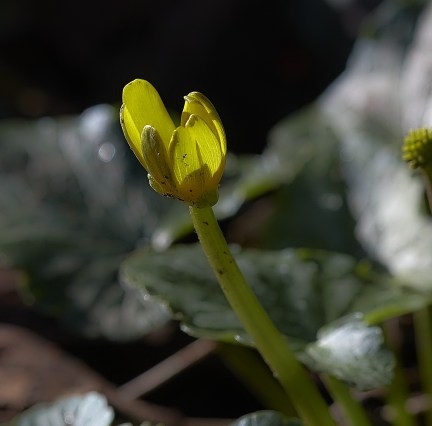
The Bosham stream had
been planted up by the inhabitants but still looked a
picture with flowering Hellebore. White and Red
dead-nettle seen. A large tree in one of the gardens
had a glorious array of yellow flowers but we could
not identify the tree. I did think maybe Cornelian
cherry? Although we did see a couple of bumble bees
not fully identified. A total of 32 species of birds
seen and heard. Thank you for enduring the
mud.
Brian's
notes
I think the tree with yellow blossom (above left)
may be Norway Maple. They flower well at this time
along Pook Lane.
The white flowers labelled Blackthorn (above right)
are probably Cherry Plum. The glossy twigs and absence
of thorns indicates Cherry Plum. Ralph Hollins always
warned us about confusing these two. Cherry Plum
always flowers before Blackthorn.
Lesser Celandines have been flowering for some while
in Bridge Road car park!
For the previous month go to . . . January
1-31